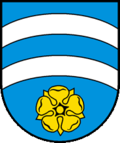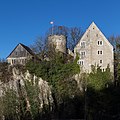Pleujouse
| Pleujouse | ||
|---|---|---|
| State : |
|
|
| Canton : |
|
|
| District : | Porrentruy | |
| Municipal municipality : | La Baroche | |
| Postal code : | 2953 | |
| former BFS no. : | 6799 | |
| Coordinates : | 582935 / 251324 | |
| Height : | 580 m above sea level M. | |
| Area : | 1.82 km² | |
| Residents: | 91 (December 31, 2007) | |
| Population density : | 50 inhabitants per km² | |
| map | ||
|
|
||
Pleujouse ( French [ pløʒuz ], in local dialect [ piəʤuːz ]; German Plützhusen / Blitzhausen ) is a village and a former political municipality in the Porrentruy district of the Swiss canton of Jura .
geography
Pleujouse lies at 580 m above sea level. M. , eleven kilometers east of the district capital Porrentruy (linear distance ). The farming village extends in an eastern side valley of the Asuel brook in the Baroche, in the eastern Ajoie (German Elsgau ) at the foot of the Chain Jura .
The area of only 1.8 square kilometers just great former municipal area includes the valley of Pleujouse that by wooded Jura mountains surrounded: to the north of La Chaux ( 701 m asl. , In the east) Les Aidjolats ( 787 m above sea level. ) and in the south the Grande Roche (at 825 m above sea level, the highest point in Pleujouse). The watershed between the catchment areas of the Rhine and Rhone runs over the range of hills from Les Aidjolats and Grande Roche . The municipality is drained to the west to the Allaine . In 1997, 3% of the municipal area was accounted for by settlements, 69% for forests and woodlands and 28% for agriculture.
Several individual farms belong to Pleujouse. Neighboring communities of Pleujouse were Charmoille , Fregiécourt , Asuel , Bourrignon and Pleigne .
population
With 91 inhabitants (at the end of 2007), Pleujouse was one of the smallest municipalities in the canton of Jura before the municipal merger. 91.3% of the residents are French-speaking, 7.5% German-speaking and 1.2% Romansh-speaking (as of 2000). The population of Pleujouse was 239 in 1850 and 135 in 1900. In the course of the 20th century, the population continued to decrease to 76 people by 1990. Since then, a slightly increasing trend has been recorded.
economy
Pleujouse is still predominantly a village characterized by agriculture , especially fruit growing . The local small business also offers some jobs. However, many workers are commuters and work in the Porrentruy region .
traffic
Pleujouse is located off the major thoroughfares on the cantonal road from Fregiécourt to Asuel, with the town center being accessible via a spur road. Pleujouse is connected to public transport via a post bus that runs between Porrentruy and Asuel.
history
The name of the village appears several times in the 12th century as a designation of origin: 1105 Lutfrido de Pluiusa ; 1136 Huzone de Pluvioso ; 1161 Phylippus de Pluuiosa ; 1173 Gerardus miles de Pluiose … Petrus miles de Pluiose . This name goes back to the Latin word pluviosus, -a, -um 'rainy' and refers either to frequent rainy weather, or to the stream that swells when it rains, along which the village lies. 1292 the German name Nùwenburc ( h ) is documented, which is later replaced by Germanized forms of the borrowed French name: early 14th century Plujusen ; 1441 Blutzhusen , called Nuwenburg .
Pleujouse shared the checkered history of the Ajoie, which came to the Duchy of Basel in 1271 . The village was under the Meieramt Alle from the 16th to the 18th century . From 1793 to 1815 Pleujouse belonged to France and was initially part of the Département du Mont-Terrible , from 1800 it was linked to the Département Haut-Rhin . By decision of the Congress of Vienna , the municipality came to the canton of Bern in 1815 and to the newly founded canton of Jura on January 1, 1979. On January 1, 2009, it was merged with Asuel , Charmoille , Fregiécourt and Miécourt to form the new municipality of La Baroche .
Attractions
The castle of the Lords of Pleujouse , built around 1100, stands on a rocky mountain promontory above the village . In addition to the circular walls, the round keep is one of the oldest structures still in existence today. The mighty house dates from the 15th century; it fell victim to a fire in 1980, but has since been restored. Pleujouse is part of the Charmoille parish and does not have its own church.
photos
Web links
- Pleujouse (French)
- Dominique Prongué: Pleujouse. In: Historical Lexicon of Switzerland .
Individual evidence
- ↑ a b Nicolas Pépin / Wulf Müller, Pleujouse JU (Porrentruy) in: Dictionnaire toponymique des communes suisses - Lexicon of Swiss community names - Dizionario toponomastico dei comuni svizzeri (DTS | LSG) , Center de dialectologie, Université de Neuchâtel, Verlag Huber, Frauenfeld / Stuttgart / Vienna 2005, ISBN 3-7193-1308-5 and Éditions Payot, Lausanne 2005, ISBN 2-601-03336-3 , p. 706








